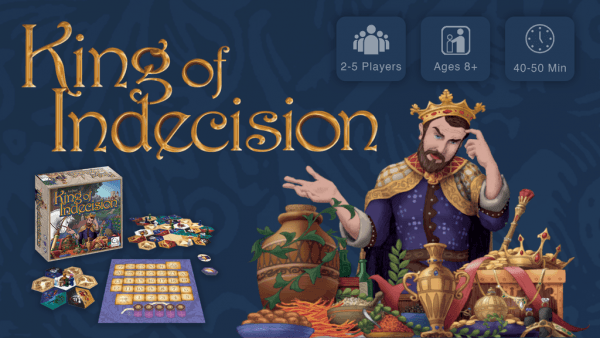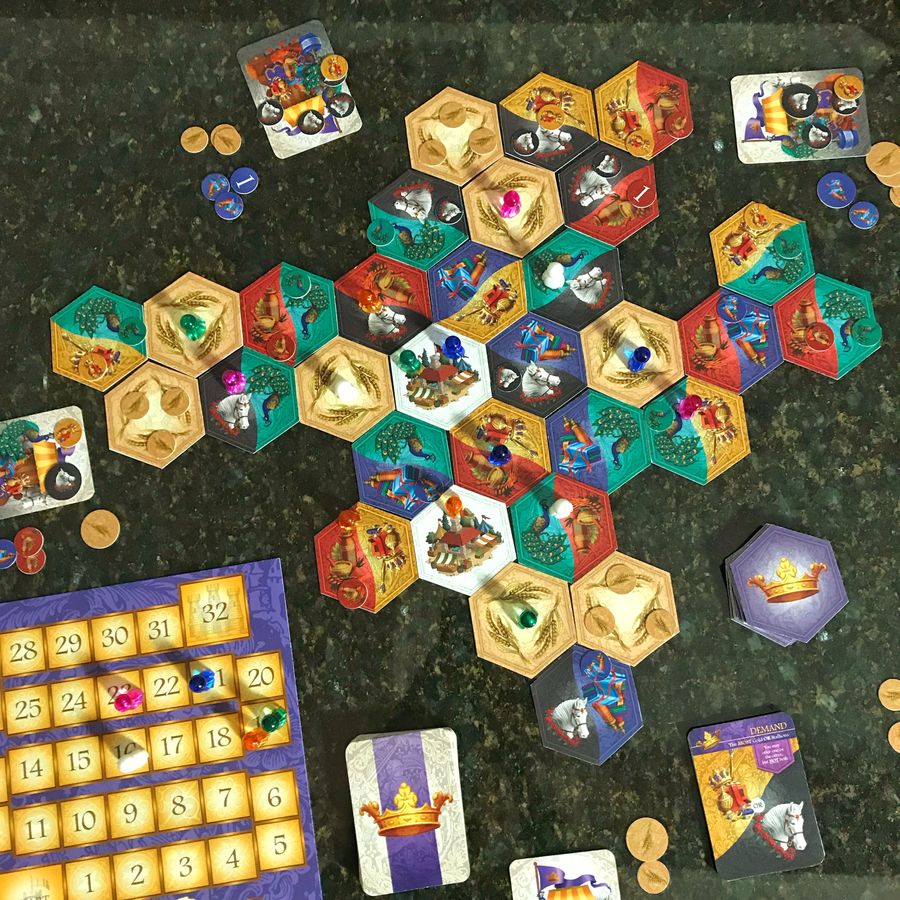Preview: Gather Resources and Push Your Luck to Satisfy the King of Indecision

The king wants peacocks. Gather as many as you can, and offer more than your opponents in order to earn his favor. But be quick about it, because before you know it he’ll have changed his mind and decided he wants stallions instead!
Currently on Kickstarter, King of Indecision has elements of tile placement, pick up and deliver, and push your luck. It’s got a fun name and enjoyable theme to fit it’s mechanics, but how does it play?
Gameplay
The game takes place over five rounds. At the end of each round, a card is drawn from the deck. There are two types of cards in the deck: demand cards and replenish cards. At the beginning of the game, the deck is put together so that a demand card will only be drawn every so often, with one placed on top of the deck to begin with.
A demand card says which of the five resources the king is currently seeking. It might show one resource, a combination of two particular resources, one or another of two resources listed on the card, or the largest combination of any of the five resources.
In the center of the table, representing the kingdom, a market tile is placed at the start of the game and six random kingdom tiles placed around it. Kingdom tiles will either show two different resources, or three wheat (a sixth resource that the king never wants but which can be used for trades and to purchase extra workers). When an increase card is drawn, players put a matching resource token on each tile on which that resource appears, even if there are already tokens present on that tile (unless it is wheat, in which case you place three wheat tokens, but only on wheat tiles that are currently empty). There are also market tiles in the tile deck. Players can use an action to move a worker from one market to another, and may trade two unwanted resources for one resource of their choice when they have a worker at a market.
Each player begins the game with a single worker on the starting market tile, and has three actions per turn. During the game, they may spend all their actions on their turn to hire a second worker (this costs any three resources) and then a third worker (for six resources). After you have unlocked your third worker, you have four actions per turn for the rest of the game.
Actions include: moving a worker from its present tile to an adjacent tile (or from market to market), collecting all of one type of resource token on your worker’s tile, making trades at a market, drawing a tile from the deck and adding it to an empty space adjacent to the worker performing the action (new tiles must connect to at least two other tiles already on the table), and committing any number of your resources as an offering to the king.
Whenever a new demand card is drawn, the previous demand card is scored. The player with the most resources of the correct type already committed as an offering scores the most points, the player with the second most scores fewer points, and the player with the third most number scores the least points. All resources in an offering that were used to score a player points are discarded, and any remaining resources in the offering are returned to the player’s personal supply. If a resource was in a player’s supply and not committed to an offering when a demand card is scored, it cannot be used to meet that demand.
The round is considered complete after a demand card is resolved, and each subsequent round, players earn more and more points for meeting the demands. After the fifth demand card is scored, players earn an additional point for each five resources still in their personal supply, the game ends, and the player with the most points wins.

Photo provided by Analog Game Studios
Review
King of Indecision is a light strategy game, with plenty of options to choose from each turn, and simple and intuitive rules.
There are also choices to be made on how to use your actions and workers, and there is always something useful you can do, even if it’s stockpiling for future demands or for trades. The game has an enjoyable escalation, too, as you unlock your fourth action and tiles expand out, offering more and more options to choose from as the game proceeds. With more players, there is more opportunity for another player’s actions to alter your plans, but there is also going to be more downtime between turns with a higher player count.
Since there’s so much uncertainty about when the king’s demands will change, there’s a certain press-your-luck element about how long you hold off on committing goods as an offering, or even how many goods to commit. You want to offer more than your opponents, but you might also not want to go all in and hold back some goods for future offerings or to purchase a new worker.
Due to how the demand cards are drawn, it is possible in the early rounds to have little to no chance to collect the necessary resources, which can be a little frustrating, but since the early rounds are worth substantially fewer points than the later rounds, there are plenty of opportunities to catch up.
While we can’t judge component quality based on the prototype we received, the artwork was bright and colorful, and tiles and cards easy to understand.
Light on rules, and an enjoyable unpredictability mixed in with strategy, King of Indecision is a lovely meeting ground for casual gamers and for players who enjoy something just a little bit weightier. Check it out on Kickstarter, and decide for yourself, unless you’re also a King of Indecision.
Pros: Catch up system in place, good choices every turn, push your luck element
Cons: Higher player count introduces longer down time, in early rounds players can sometimes have little to no opportunity to fulfill demand cards depending on card draw and tile placement
Disclosure: this preview is based on our evaluation of an unpublished prototype of the game, which is subject to change prior to publication. While a modest payment was received to expedite the review process, our thoughts and opinions expressed here are honest and accurate.




